Physical Address
304 North Cardinal St.
Dorchester Center, MA 02124
Hyalohyphomycosis is fungal disease caused by a variety of molds that produce hyaline, septate hyphae with narrow hyphae that range from 2 to 6 μm in diameter. These include Aspergillus species, Fusarium species, Scedosporium species, and others. Zygomycete hyphae are also hyaline but are much broader with sparse septations, and these are discussed in a separate chapter. Hyalohyphomycetes are the counterpart to the phaeohyphomycetes, which produce pigmented, septate hyphae. Hyalohyphomycetes produce a wide spectrum of clinical syndromes, whereas phaeohyphomycetes produce only several well-defined pathologic presentations including phaeohyphomycotic cyst and mycetoma.
The morphology of the various hyalohyphomycetes is often indistinguishable from each other in cytologic preparations or paraffin-embedded tissues stained with routine histologic stains, and often the nature of the disease process is not specific to a particular genus. The identification of these molds is important with respect to the selection of appropriate treatment. Amphotericin B has long been a first-line agent to be used for serious fungal infections. However, variation exists among the hyalohyphomycetes with respect to amphotericin B susceptibility. Fusarium, Scedosporium apiospermum, and Aspergillus terreus may possess decreased susceptibility to amphotericin B. And no longer is amphotericin B the only available antifungal agent for systemic infections. A variety of newer antifungal agents including the triazoles have markedly different susceptibilities among the invasive molds. A careful and reasoned diagnosis of the invasive molds is critical for appropriate patient treatment. In every way similar to the pathologist’s approach to tumor diagnosis, tissue diagnosis of the invasive molds must be inclusive of all possible diagnoses in order to allow the best treatment. Many times the pathologist may be unable to specifically identify molds in tissue. Culture or molecular methods are necessary for specific identification.
ASPERGILLOSIS
Aspergillus species remain the predominant pathogens among the hyalohyphomycetes, and the incidence of Aspergillus infection has increased with the use of immunosuppressive therapies particularly those inducing neutropenia (neutrophil count < 500/μm). Aspergillus is found worldwide in decomposing organic material. The ability of A. fumigatus to grow at elevated temperatures as well as to utilize a variety of substrates for nutrition explains its role as a major human pathogen. In a study of multiple transplant centers between 1988 and 2002, A. fumigatus made up over half of the invasive fungal infections in solid organ and human stem cell transplant (HSCT) patients. Other Aspergillus species contributed to an additional 15% of solid organ and 26% of HSCT patients. Non- fumigatus species of Aspergillus are increasingly seen in human infections. Although Aspergillus fumigatus remains the most frequent Aspergillus species implicated in human infections, its role has diminished from about 90% of all Aspergillus infections in the 1980s to about 50% to 60% in the 2000s. Other important Aspergillus species causing human infections include A. flavus, A. terreus, A. niger, A. versicolor, and A. nidulans. Aspergillus lentulus is an uncommon clinical isolate that resembles A. fumigatus but is not as thermotolerant and is more resistant to antifungal agents.
Aspergillus participates in a wide range of clinical syndromes from allergy to colonization to invasive disease. Colonization, as in aspergillomas of the nasal sinus or lung, tends to occur in individuals with normal immune function. The more severe, invasive disease most often occurs in patients with impaired immunity particularly neutropenia. Affected patients may include those with both hematologic as well as solid malignancies in addition to transplant patients. HIV/AIDS patients are not commonly infected with Aspergillus unless neutropenia intervenes. Invasive aspergillosis can occur rarely in patients with overtly normal immune systems. In those profoundly immunocompromised patients with invasive aspergillosis, the disease course is rapid leading to death in as high as 72% of infected patients even with aggressive antifungal treatment. In invasive aspergillosis, tissues demonstrate extensive proliferation of hyphae with angioinvasion and tissue necrosis. Biopsies from patients with less severe immune dysfunction, such as chronic granulomatous disease of childhood, may present fewer hyphae with an inflammatory and granulomatous response.
ALLERGIC BRONCHOPULMONARY ASPERGILLOSIS
Patients with allergic bronchopulmonary aspergillosis (ABPA) manifest an allergic reaction to Aspergillus spp.—most commonly Aspergillus fumigatus —with wheezing, central bronchiectasis, production of sputum plugs containing Aspergillus, and recurrent pulmonary infiltrates. ABPA may develop in small numbers of patients with asthma and cystic fibrosis in a progression as follows: bronchial allergic reactions develop to inhaled Aspergillus conidia, mucus plugs proximal bronchi, and bronchial plugging produces atelectasis and transient pulmonary infiltrates. Many patients have multiple episodes of acute disease that may progress to pulmonary fibrosis.
Major criteria for the diagnosis of ABPA include asthma, eosinophilia, pulmonary infiltrates, immediate skin test reactivity to Aspergillus, precipitating antibodies (IgG) to Aspergillus, and elevated serum IgE. Minor criteria include Aspergillus species in sputum, production of mucus plugs containing eosinophils, and infiltrates in chest radiographs suggesting bronchial inflammation.
Major criteria:
Asthma.
Peripheral eosinophilia.
Pulmonary infiltrates.
Immediate skin test reactivity to Aspergillus.
Precipitating antibodies (IgG) to Aspergillus.
Elevated serum IgE.
Minor criteria:
Aspergillus spp. in sputum.
Mucus plugs containing eosinophils.
Infiltrates in chest radiographs suggesting bronchial inflammation.
Aspergillus species are found worldwide especially in decomposing organic material.
Clinical presentation characterized by wheezing and production of sputum plugs often containing Aspergillus.
Migrating, transient pulmonary infiltrates especially in the apical segments of the upper lobes are often noted on chest radiographs.
Bronchial wall thickening and dilatation are sometimes also seen.
Cavitation is rare.
In more severe disease, bronchodilators and glucocorticoids may be helpful.
Some authorities have recommended the use of itraconazole.
Various resolving and recurring (migratory) upper lobe pulmonary infiltrates with hilar and paratracheal lymphadenopathy may be present. Bronchial wall thickening and dilatation are sometimes seen. In longstanding disease, chest radiographs in allergic bronchopulmonary aspergillosis may show linear shadows, narrowed vascular markings, and volume loss in one or more lobes of the lung that may progress to upper zone fibrosis and central bronchiectasis. Cavitation is rare.
Bronchiectasis involves segmental and subsegmental bronchi. Mucus plugs may be found containing Curschmann spirals, Charcot-Leyden crystals, eosinophils, and other leukocytes. Allergic bronchopulmonary aspergillosis is not diagnosed by gross or microscopic findings. Pathologic findings vary.
Allergic bronchopulmonary aspergillosis is not diagnosed by gross or microscopic findings.
Bronchiectasis involves segmental and subsegmental bronchi.
Mucus plugs may be found containing Curschmann spirals, Charcot-Leyden crystals, eosinophils, and other leukocytes.
Laboratory studies include agar gel precipitin test to Aspergillus antibodies, elevated serum IgE (> 500 IU/mL), specific IgE and IgG antibodies to Aspergillus antigens, and peripheral eosinophilia. Although culture of Aspergillus from sputum plugs constitutes a minor criterion for ABPA, negative fungal cultures do not exclude the diagnosis.
Although testing for specific IgG and IgE antibodies to Aspergillus antibodies represents the major laboratory means of identifying ABPA, the sensitivity and specificity of this testing are not high. However, mucus plugging, pulmonary infiltrates, and eosinophilia are not always due to Aspergillus allergy but can also be seen in filariasis and polyarteritis nodosa. Endobronchial colonization of patients with bronchiectasis may induce Aspergillus antibodies in the absence of ABPA. Separating ABPA from fungal or bacterial pneumonias is usually not difficult in that ABPA usually does not produce fever, leukocytosis, or prostration.
Allergic bronchopulmonary aspergillosis makes up one part of the allergic manifestations of Aspergillus, which also includes extrinsic asthma to Aspergillus antigens and extrinsic allergic alveolitis. Extrinsic asthma due to Aspergillus is characterized by serum IgE to Aspergillus antigens but usually not IgG. Extrinsic asthma is a reversible airway disease, and ABPA is irreversible. Extrinsic allergic alveolitis is a condition that may develop in individuals exposed to large quantities of Aspergillus conidia such as in workers handling moldy grain. “Malt worker’s lung” is an example. Susceptible workers may develop cough, dyspnea, and sometimes fever hours after inhalation of moldy dust. Extrinsic allergic alveolitis involves the lung parenchyma not the airways. Serum IgE to Aspergillus is usually negative but serum IgG is positive. Sputum cultures have no value in the evaluation of extrinsic asthma or extrinsic allergic alveolitis.
In severe disease, glucocorticoids and bronchodilators can be helpful and may improve lung function as well as diminish serious long-term pulmonary damage and fibrosis. Although antifungal treatment has previously been considered of no benefit to ABPA patients, studies suggest that itraconazole may be of benefit to ABPA patients.
ASPERGILLUS OTOMYCOSIS
Otomycosis is the colonization of the external auditory canal with Aspergillus.
Etiologic agents include A. niger and A. fumigatus . Patients present with impaired hearing or itching, pain, or discharge from the external auditory canal.
Black fuzzy growth (in the case of A. niger ) or green, fuzzy growth (in the case of A. fumigatus ) is seen in the external auditory canal. No tissue invasion is present.
Material obtained by otoscopy should be cultured. In the otherwise overtly normal host, this disease remains limited to the external auditory canal.
Other bacterial and fungal organisms can colonize the external auditory canal. Otoscopy with examination and culture of canal contents is diagnostic.
Colonization of the external auditory canal with Aspergillus, primarily A. niger and A. fumigatus.
Aspergillus species are found worldwide in decomposing organic material.
Black or green fuzzy growth visualized in external auditory canal.
Prognosis is good with debridement and antifungal treatment.
Aspergilloma or fungus ball, here present in the external auditory canal, is a mass of hyphae and proteinaceous matrix developing as a result of colonization within the external auditory canal.
Aspergillomas consist of radiating hyphae in a proteinaceous matrix.
Fruiting heads of Aspergillus also may be seen at the outer edge of a fungus ball.
Oxalate crystals may be present in an aspergilloma caused by A. niger.
Most patients may experience a chronic course of disease with periodic exacerbations particularly in the summer months. Prognosis is good with antifungal treatment. Aspergillus otomycosis can spread contiguously to the brain in immune-impaired patients.
ASPERGILLOMA
An Aspergillus fungus ball or aspergilloma can develop in the sinuses or within a preexisting lung cavity. Aspergillomas consist of masses of hyphae, mucus, and debris that form as a result of colonization. In the lung, an aspergilloma is contained within a thick fibrous wall without invasion. Involved cavities are often the residua of resolved tuberculosis. Similarly in the sinus cavity, sinus mucosa is not invaded. Aspergillus fumigatus, A. flavus, and A. niger are most often associated with aspergillomas.
Patients with paranasal sinus aspergilloma present with a long history of chronic sinusitis with nasal congestion, postnasal drip, congestion, and sinus pain. Acute bacterial sinusitis frequently occurs. Cough, malaise, and weight loss may be noted. Some patients with lung aspergillomas may be asymptomatic, although hemoptysis may occur in a majority of lung aspergillomas and can be massive.
Radiographs of sinus aspergillomas may show increased radiodensity. Calcium phosphate deposition in some lesions can considerably increase the density. Aspergillomas of lung have a characteristic x-ray appearance of a rounded, uniform opacity with a crescent over the upper portion of an internal mass. The crescent is produced by free air over the mass of hyphae and is termed Monod sign. Sometimes a lung aspergilloma may shift within the cavity as x-rays are taken with different patient positions ( Figure 23-1 ).
Aspergilloma or fungus ball is a mass of hyphae and proteinaceous matrix developing as a result of colonization within the paranasal sinuses or lung.
The maxillary sinus is most often affected.
In the lung, colonization of old tuberculous cavities is common.
Aspergillus is found worldwide in decomposing organic material.
Aspergillus fumigatus, A. flavus , and A. niger are most often associated with aspergillomas.
There is a long history of chronic sinusitis frequently with episodes of acute bacterial infections in patients who develop paranasal aspergillomas.
Lung aspergillomas are often asymptomatic but pose a significant risk for hemoptysis.
Sinus aspergillomas demonstrate an increased radiodensity that merges with the sinus mucosa.
Lung aspergillomas consist of rounded opacities often with a crescent overlying the fungus ball.
The aspergilloma may move within the lung cavity as the patient assumes different positions.
Sinus aspergillomas are usually cured by adequate surgical curetting.
Antifungal treatment is not generally useful.
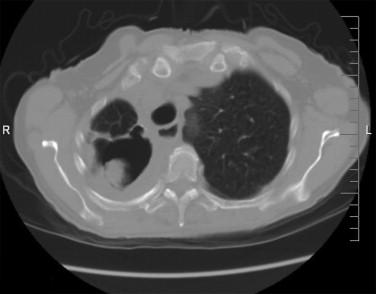
The maxillary sinus is the most frequent location for a sinus aspergilloma, but the other sinuses may be involved less frequently. As the surgeon removes a sinus aspergilloma, a brown-to-green, cheesy material covered with mucus is curetted from the nasal cavity. The pathologist often receives fragmented material for examination. These fragments may aggregate to 1 to 2 centimeters in diameter.
In the lung, fungus balls may reach a diameter of several centimeters. Fungus balls have a soft consistency. The lining of the surrounding pulmonary cavity is smooth, white, and firm. Adjacent pleura may be thickened.
Aspergillomas consist of radiating hyphae in a proteinaceous matrix. Aspergillus hyphae stain well with hematoxylin and eosin (H&E) stains and may possibly stain a darker blue near the rim of the aspergilloma. This bandlike pattern may be replicated in periodic acid-Schiff (PAS) and Gomori methenamine silver (GMS) staining ( Figure 23-2 ). Material from a fragmented fungus ball may demonstrate degenerated hyphae. Regular septation with acute-angle branching is best appreciated near the outer edge of a fungus ball where vesicles producing conidia or “fruiting heads” of Aspergillus also may be seen. Vesicles of A. niger and A. fumigatus can be identified in surgical specimens as long as sectioning was performed in a plane demonstrating the conidiophore insertion ( Figures 23-3 and 23-4 ). If the aspergilloma is formed by A. niger , calcium oxalate may be demonstrated by polarized light from within the aspergilloma. In lung aspergillomas, there usually is no evidence of invasion of the fibrotic pulmonary cavity by hyphae. Respiratory epithelium sometimes with foci of squamous metaplasia often lines a cavity wall composed of chronic inflamed fibrous connective tissue. Granulomatous inflammation is generally absent. In the case of sinus aspergillomas, sinus mucosa is folded and hypersecretory with an edematous, mildly inflamed submucosa.
Sinus aspergilloma: the maxillary sinus is the most frequent location for a sinus aspergilloma but the other sinuses may be involved.
Pulmonary aspergilloma: fungus balls may reach a diameter of several centimeters.
Aspergillomas consist of radiating hyphae in a proteinaceous matrix.
Fruiting heads of Aspergillus also may be seen at the outer edge of a fungus ball.
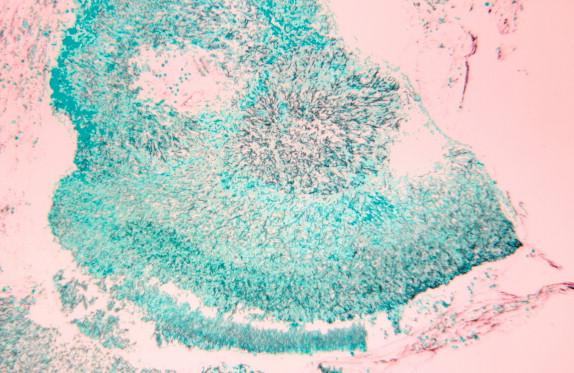
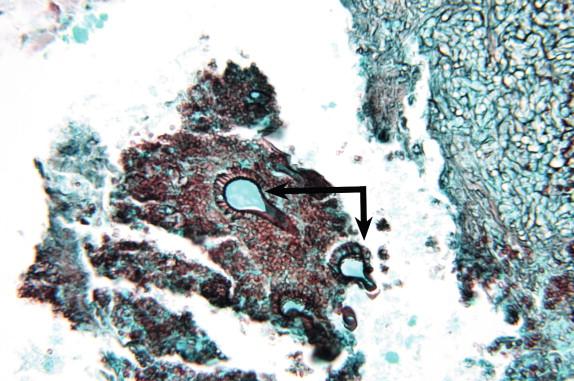
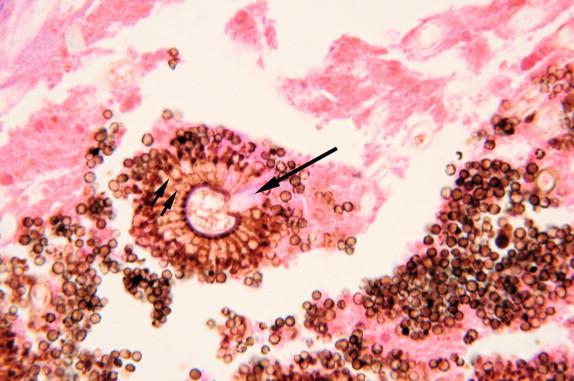
Bronchial lavage fluid culture from a patient with an aspergilloma is usually negative in that fungus balls usually do not communicate with bronchi. Needle-biopsy or surgical excision is most often necessary to provide culture material. Serology may be useful in patients with aspergillomas, and demonstration by immunodiffusion of four or more Aspergillus antigens is highly suggestive of aspergilloma of some body cavity.
Fungus balls have been produced by other fungi including Scedosporium apiospermum, Coccidioides immitis ( Figures 23-5 and 23-6 ), zygomycetes, and others.
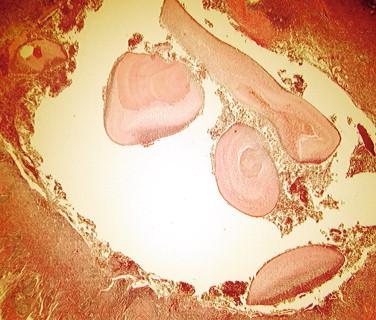
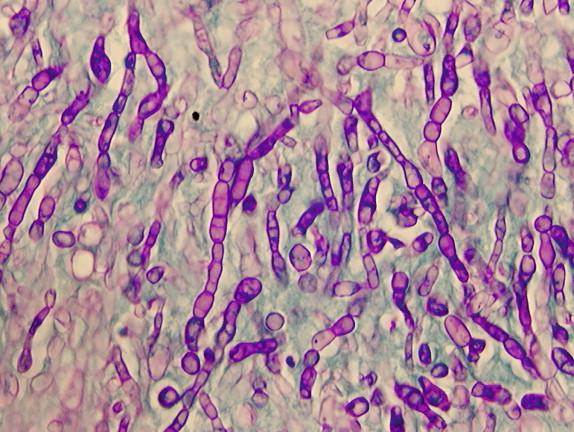
Pathologists are commonly presented with mycelial masses removed from nasal sinuses and microscopically find degenerated, broad hyphae that may superficially suggest zygomycetes ( Figure 23-7 ). Numerous septa suggest a nonzygomycete, hyaline mold. Further examination for fruiting heads may support the diagnosis of an Aspergillus species.
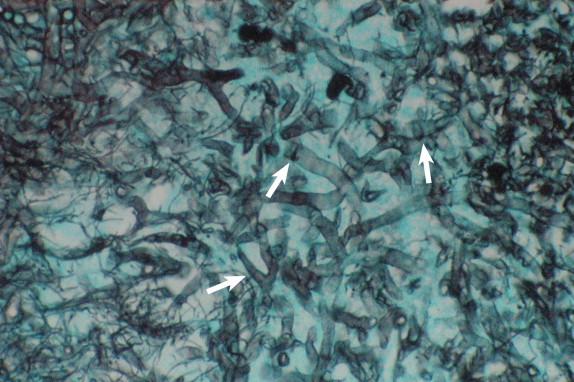
Hyphae of the various hyalohyphomycetes including Aspergillus may be difficult to impossible to distinguish from each other. In cases of non- Aspergillus fungus balls, serology for Aspergillus would be negative. When a chest radiograph demonstrates a lesion with the rounded appearance of a fungus ball, an organized hematoma or necrotic lung should also be considered.
Sinus disease without aspergilloma has been recognized. Acute invasive sinusitis occurs predominantly in severely immunocompromised patients, particularly those with hematologic malignancies. The disease is manifested by a rapidly destructive sinusitis spreading to the orbit, brain, or carotid artery. Tissue necrosis and vascular invasion by Aspergillus hyphae is seen. Sometimes the fragmented curettage specimen from invasive sinus disease may show abundant hyphae that may be difficult to distinguish from aspergilloma. Radiographs showing sinus invasion as well as positive blood galactomannan may help to establish the diagnosis.
Another form of Aspergillus sinusitis known as chronic granulomatous sinusitis is restricted to northern Africa, the Middle East, and India. Aspergillus flavus is implicated in most cases. Florid granulomatous inflammation involves the ethmoid sinuses and extends to the cavernous sinus, orbit, and brain. The clinical appearance is that of a tumor.
Colonization of bronchi by Aspergillus is possible and may lead to consistently positive sputum cultures for Aspergillus. In such patients, serology for Aspergillus would be negative. Underlying diseases such as cystic fibrosis, bronchiectasis, or chronic bronchitis can form bronchial casts of mucoid material and hyphae. These are not true fungal balls and any tissue injury would be produced by the underlying disease.
A chronic form of progressive, cavitary lung disease— possibly with fungus balls—has been described as “chronic pulmonary aspergillosis” or “chronic necrotizing pulmonary aspergillosis.” This condition has been described mainly in middle-aged patients with preexisting lung disease or defects in immunity including diabetes or corticosteroid use. In these patients, chronic respiratory symptoms develop gradually over years. Progression of radiologic abnormalities may be useful to track the disease, especially increasing cavitation and thickening about the cavity. Lack of respiratory symptoms would help separate the usually asymptomatic lung aspergilloma from chronic pulmonary aspergillosis.
Aspergilloma of the bladder is a rare condition reported both in association with disseminated aspergillosis as well as in otherwise normal hosts.
Aspergilloma of the paranasal sinus rarely recurs after adequate surgical curetting of the affected sinus. If untreated, increase in size of lung aspergillomas can occur. Resolution of lung aspergillomas is not common. There is risk of massive, exsanguinating hemorrhage from enlarging lung aspergillomas, so surgical removal is often advised. In patients with coexisting sarcoid and lung aspergillomas, steroid treatment has been associated with the development of invasive aspergillosis. Antifungal treatment is of limited value in that drug penetration into fungal ball cavities may be negligible.
ASPERGILLOSIS IN CHRONIC GRANULOMATOUS DISEASE
Chronic granulomatous disease (CGD) is an unusual disorder of phagocytic cells that occurs in 1:200,000 live births. The mortality rate is 2% per year with about one third of all deaths caused by Aspergillus infection. CGD is an inherited disorder caused by mutations in NADP-reduced oxidase complex and characterized by recurrent bacterial and fungal infections. NADP-reduced oxidase complex produces reactive oxygen species that are critical for phagocyte killing of Aspergillus hyphae as well as bacteria and other microorganisms.
Chronic granulomatous disease of childhood often presents a less serious clinical picture than that seen in neutropenic patients. Patients are often less than 2 years old at onset of CGD. Fever is a common presenting complaint. The disease usually remains localized to the chest but may extend to involve contiguous ribs or vertebral bodies. Common symptoms include generalized lymphadenopathy, hepatosplenomegaly (possibly with abscess formation), recurring pneumonia with varied microorganisms, recurring skin furuncles, and perianal abscesses. Osteomyelitis, particularly of the small bones of the hands and feet, is sometimes seen. Esophageal and gastrointestinal lesions are often seen.
CGD is an inherited disorder caused by mutations in NADP-reduced oxidase complex and characterized by recurrent bacterial and fungal infections with significant mortality and morbidity due to Aspergillus .
CGD is an inherited disorder caused by mutations in NADP - reduced oxidase complex occurring in 1:200,000 live births.
Chronic granulomatous disease of childhood often presents a less serious clinical picture than that seen in neutropenic patients.
The disease usually remains localized to the chest but may extend to involve contiguous ribs or vertebral bodies.
Common symptoms include generalized lymphadenopathy, hepatosplenomegaly possibly with abscess formation, recurring pneumonia with varied microorganisms, recurring skin furuncles, and perianal abscesses.
CT findings may be the first indication of infection.
Inhalation of Aspergillus conidia leads to multiple lung nodules, suggesting miliary tuberculosis.
Lesions may be present in lungs, brain, chest wall, liver, spleen, esophagus/GI tract or lymph nodes.
Approximately 20% of CGD patients are carriers of Aspergillus, and these individuals are at high risk for developing disseminated pulmonary infections.
Long-term use of antibiotics including itraconazole as well as prophylactic use of gamma-interferon has improved the clinical course of the disease.
Inhalation of Aspergillus conidia leads to multiple lung nodules suggesting miliary tuberculosis. In severe disease, consolidating pneumonia can develop ( Figure 23-8 ). Lesions may be present in the lungs, brain, chest wall, liver, spleen, esophagus/gastrointestinal (GI) tract or lymph nodes. CT findings may be the first indication of infection. Recurrent liver abscesses due to Staphylococcus aureus may produce liver calcifications.
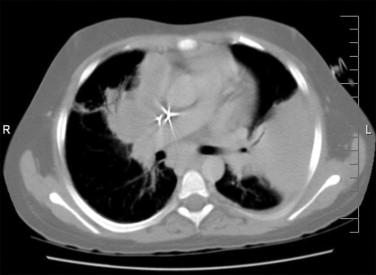
Become a Clinical Tree membership for Full access and enjoy Unlimited articles
If you are a member. Log in here